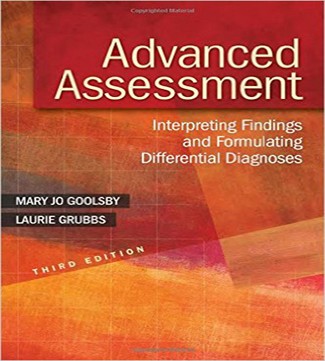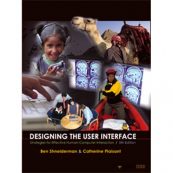Advanced Assessment Interpreting Findings and Formulating Differential Diagnoses 3rd Edition Goolsby Grubbs Test Bank
$38.00
Advanced Assessment Interpreting Findings and Formulating Differential Diagnoses 3rd Edition Goolsby Grubbs Test Bank Download
- Description
- Reviews (0)
Description
You will receive this product immediate after placing the order
ISBN-10: 0803643632
ISBN-13: 9780803643635 978-0803643635
Chapter 3. Skin
Multiple Choice
Identify the choice that best completes the statement or answers the question.
____ 1. When a patient presents with a skin-related complaint, it is important to first:
A. Fully inspect all skin lesions before asking the patient how the lesion in question developed
B. Obtain a full history about the development of the skin lesion prior to the physical examination
C. Complete a full physical examination of the body prior to inspecting the skin lesion
D. Examine the skin lesion without hearing a health history in order to not prejudice the diagnosis
____ 2. Jaundice is a state of high bilirubin in the bloodstream. It is most commonly seen first in the:
A. Sclera
B. Nailbeds
C. Palms of the hands
D. Unexposed skin areas
____ 3. Skin turgor is best assessed by pinching skin over the:
A. Forehead
B. Forearm
C. Knees
D. Dorsum of the hand
____ 4. What kind of lesions are caused by the herpes simplex virus?
A. Scales
B. Vesicles
C. Plaques
D. Urticaria
____ 5. A patient presents with vesicles on a reddened base in a symmetrical pattern on the lower neck and upper back, stating that he had noticed discomfort prior to the onset of the “rash.” Which of the following should be considered in your differential diagnosis?
A. Dermatitis herpetiformis
B. Herpes zoster
C. Dishydrosis
D. Contact dermatitis
____ 6. Herpetic whitlow is commonly located on:
A. The eyelid
B. The scalp
C. A finger
D. Lip
____ 7. Which type of lesion is referred to as resembling “a dew drop on a rose petal?”
A. Varicella zoster
B. Measles
C. Rubella
D. Tinea
____ 8. Which lesions are typically located along the distribution of dermatome?
A. Scabies
B. Herpes zoster
C. Tinea
D. Dishydrosis
____ 9. Folliculitis is most commonly due to:
A. Contact dermatitis
B. Varicella zoster
C. Dermatophytes
D. Staphylococcal infection
____ 10. A patient presents with polymorphous lesions consisting of small, red papules and vesicles, with a few eroded and crusted lesions. Your differential diagnosis should include all except which of the following?
A. Herpes simplex
B. Varicella
C. Bacterial folliculitis
D. Contactdermatitis
____ 11. The following has been associated with cervical and anal cancer:
A. Secondary syphilis
B. Human papilloma virus
C. Herpes simplex
D. Epstein-Barr virus
____ 12. During a routine exam, you notice a 5 mm lesion on the right medial cheek. The border is raised and pearlescent in color and the area is crusted. The patient admits that it has been present for several months and has only recently become tender with the development of the crusting. This is most likely:
A. Squamous cell carcinoma
B. Epidermoid cyst
C. Basal cell carcinoma
D. Actinic keratosis
____ 13. A patient has a tender, firm, nodular cystic lesion on his scalp that produces cheesy discharge with foul odor. This is most likely a:
A. Bacterial folliculitis
B. Basal cell carcinoma
C. Bullous impetigo
D. Epidermoid cyst
____ 14. Which of the following is not associated with development of erythema multiforme?
A. Herpes virus
B. Mycoplasms
C. Medications
D. Trauma
____ 15. Your patient complains of a progressive loss of pigment in various patches on the body. Affected skin surfaces are otherwise normal (e.g. no scaling, vesicles, elevation, or other changes). The most likely cause is:
A. Vitiligo
B. Acanthosis nigricans
C. Psoriasis
D. Pityriasis alba
____ 16. A patient has an irregularly shaped, brown to black lesion on the upper arm that has changed color recently. The widest diameter is 6 mm. You should:
A. Measure and record the dimensions and schedule follow-up to repeat measurement in 2 weeks
B. Biopsy the lesion
C. Obtain skin scraping for dermatophytes
D. All of the above
____ 17. Which of the following skin disorders is associated with diabetes?
A. Acanthosis nigricans
B. Vitiligo
C. Impetigo
D. Folliculitis
____ 18. Which of the following disorders often presents in patients with café-au-lait spots ?
A. Diabetes
B. Malignancy
C. Neurofibromatosis
D. Autoimmune disease
____ 19. Patient presents with complaint of a “swollen node” under his arm. The area is tender and the node has progressed in size over the past few days. Which of the following should be included in your differential diagnosis?
A. Hidradenitis suppurativa
B. Epidermoid cyst
C. Furuncle
D. Both A and C
____ 20. Which of the following skin conditions frequently heralds an anaphylactic reaction?
A. Contact dermatitis
B. Eczema
C. Urticaria
D. Erythema multiforme
____ 21. A patient with sarcoidosis has firm, tender, reddened nodules, along the anterior aspect of the leg. These lesions are called:
A. Erythema multiforme
B. Erythema nodosum
C. A discoid rash
D. Lichen planus
____ 22. A patient suffered a laceration of the shin three days ago, and today presents with a painful, warm, red swollen region around the area. The laceration has a purulent exudate. The clinician should recognize that the infected region is called:
A. Contact dermatitis
B. Folliculitis
C. Hidradenitis suppurative
D. Cellulitis
____ 23. A woman complains of malaise and arthralgias. You note a butterfly-shaped, macular, erythematous rash across her cheeks and nose. These conditions are common in:
A. Psoriasis
B. Lichen planus
C. Systemic lupus erythematosus
D. Erythema nodosum
____ 24. Which of the following characteristics is not helpful in differentiating between psoriasis and atopic dermatitis?
A. Distribution
B. Family history
C. Lesion morphology
D. Chronicity
____ 25. A patient presents complaining of recent onset of aching and malaise followed by the development of a generalized rash. He denies previous rash although he does admit that about a month ago he had an open sore on his right hand that was nonpainful. The exam reveals a maculopapular rash and lymphadenopathy. This presentation is most consistent with:
A. Pityriasis rosea
B. Secondary syphilis
C. Herpetic whitlow
D. Pyogenic granuloma
Chapter 3. Skin
Answer Section
MULTIPLE CHOICE
1. ANS: B
When a patient presents with a skin-related complaint, there is an inclination to immediately examine the skin, as the lesion or change is often readily observable. However, it is crucial to obtain a history before proceeding to the examination in order to understand the background of the problem. A thorough symptom analysis is essential.
PTS: 1
2. ANS: A
Jaundice indicates an elevation in bilirubin and often is evident in the sclera and mucous membranes before it is obvious in the skin.
PTS: 1
3. ANS: B
The skin overlying the forehead or dorsal hand is more likely to provide a false impression of tenting or decreased elasticity; therefore, turgor should be tested by gently pinching a fold of skin over the abdomen, forearm, or sternum.
PTS: 1
4. ANS: B
The skin lesions of herpes consist of multiple vesicles, which cluster and are usually preceded by an area of tender erythema. The vesicles erode, forming ulcerations.
PTS: 1
5. ANS: A
Pruritus, burning, or stinging at the site often precedes the development of skin lesions. The lesions consist of clustered vesicles on a reddened base. The lesions have a herpetiform configuration, and the distribution is symmetrical. The extensor surfaces of the knees and elbows are often affected, as are the posterior scalp, neck, back, and thighs.
PTS: 1
6. ANS: C
Herpetic whitlow, a herpetic lesion on the finger, is usually a result of self-contamination of an infected patient to a skin break on the finger.
PTS: 1
7. ANS: A
Similar to other herpes lesions, varicella lesions progress from an area of redness to form a vesicle, then become pustular, and finally ulcerate. The vesicles look like a dewdrop on a rose petal.
PTS: 1
Be the first to review “Advanced Assessment Interpreting Findings and Formulating Differential Diagnoses 3rd Edition Goolsby Grubbs Test Bank”
You must be logged in to post a review.














Reviews
There are no reviews yet.